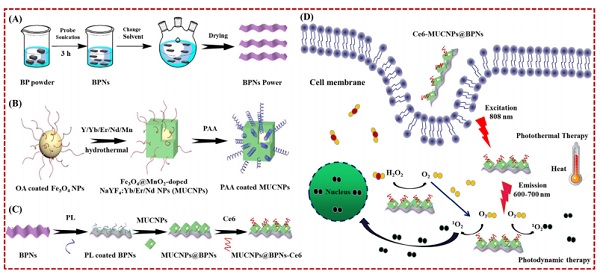周宁琳教授课题组在CHEMICAL ENGINEERING JOURNAL发表研究论文
A theranostic nanocomposite with integrated black phosphorus nanosheet, Fe3O4@MnO2-dopedupconversion nanoparticles and chlorin for simultaneous multimodal imaging, highly efficient photodynamic and photothermal therapy
Zhang, QC (Zhang, Qicheng)[ 1 ] ; Wang, WT (Wang, Wentao)[ 1,2 ] ; Zhang, M (Zhang, Ming)[ 1,2 ]*; Wu, F (Wu, Fan)[ 1 ] ; Zheng, T (Zheng, Tao)[ 2 ] ; Sheng, BL (Sheng, Bulei)[ 3 ] ; Liu, YH (Liu, Yihan)[ 1 ] ; Shen, J (Shen, Jian)[ 1 ] ; Zhou, NL (Zhou, Ninglin)[ 1 ]*(周宁琳); Sun, Y (Sun, Yi)[ 2 ]*
[ 1 ] Nanjing Normal Univ, Sch Chem & Mat Sci, Jiangsu Collaborat Innovat Ctr Biomed Funct Mat, Nanjing 210023, Peoples R China
[ 2 ] Tech Univ Denmark, Dept Hlth Technol, DK-2800 Lyngby, Denmark
[ 3 ] Aarhus Univ, Dept Food Sci, DK-8830 Tjele, Denmark
CHEMICAL ENGINEERING JOURNAL,202007,391,123525
As a novel photosensitizer for photodynamic therapy (PDT), black phosphorus (BP) has attracted increasing attention recently. However, some of its inherent drawbacks hinder its further biomedical applications. As with most conventional photosensitizers, the PDT efficiency of BP is severely limited by the hypoxia tumor microenvironment and low tissue penetration of ultraviolet/visible light. Moreover, BP also faces additional problems, such as mismatch wavelength between photothermal therapy (PTT) and PDT, as well as no imaging ability for cancer diagnosis. Herein, we addressed these challenges through the combination of Fe3O4@MnO2-doped upconversion nanoparticles (UCNPs) and black phosphorus nanosheets (BPNs). By applying polyacrylic acid (PAA) as a chemical crosslinker, polylysine (PL) modified black phosphorus nanosheets were integrated with magnetic Fe3O4@MnO2-doped NaYF4:Yb/Er/Nd upconversion nanoparticles (MUCNPs) which could convert near-infrared (NIR) light into visible light. Then, a biocompatible photosensitizer, chlorin e6 (Ce6) was attached onto the obtained MUCNPs@BPNs to prepare MUCNPs@BPNs-Ce6 nanocomposites. BPNs and Ce6 were exploited to activate PTT and PDT under a single irradiation light of 808 nm with strong tissue penetration ability. Meanwhile, the doped Fe3O4 and MnO2 nanoparticles could provide T1 and T2 magnetic resonance (MR) imaging, which could form a multimodal imaging system with fluorescence imaging of Ce6. In addition, MnO2 could decompose overexpressed H2O2 in tumor microenvironment to generate O-2 to enhance PDT. The magnetic BPNs-based nanocomposites provided multimodal imaging (including MR, fluorescence, optoacoustic, ultrasonic imaging) and displayed dramatically enhanced ability for tumor cell death with visualized synergistic phototherapy, which greatly facilitated the application of BPNs in biomedicine.

文章链接:
https://www.sciencedirect.com/science/article/abs/pii/S1385894719329407?via%3Dihub
版权与免责声明:本网页的内容由收集互联网上公开发布的信息整理获得。目的在于传递信息及分享,并不意味着赞同其观点或证实其真实性,也不构成其他建议。仅提供交流平台,不为其版权负责。如涉及侵权,请联系我们及时修改或删除。邮箱:sales@allpeptide.com